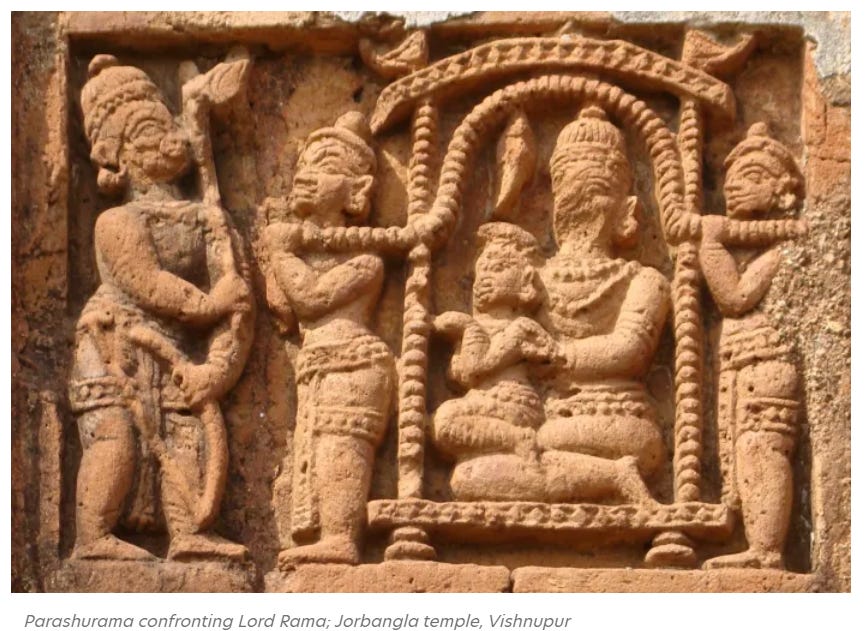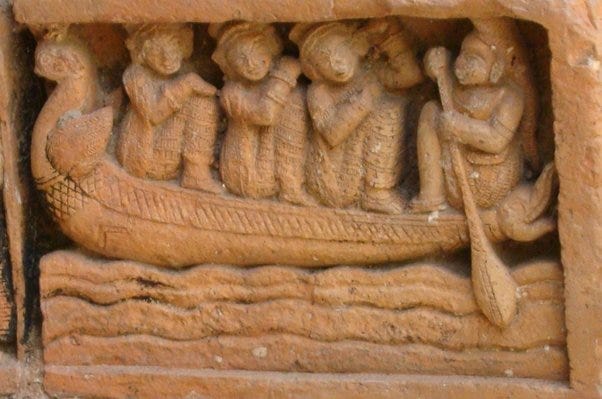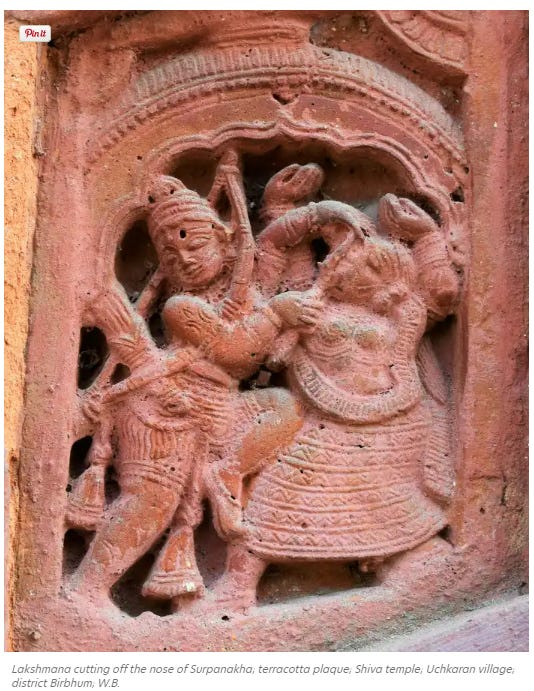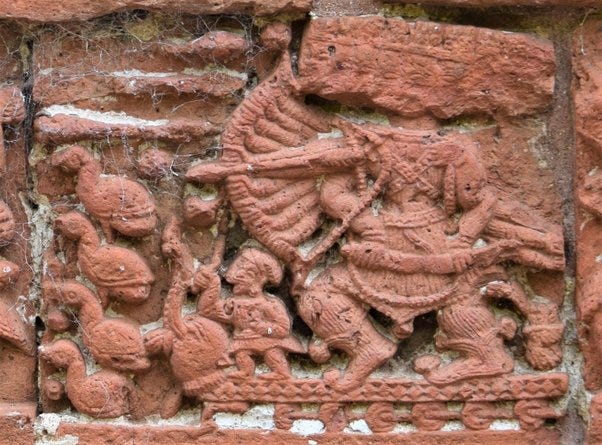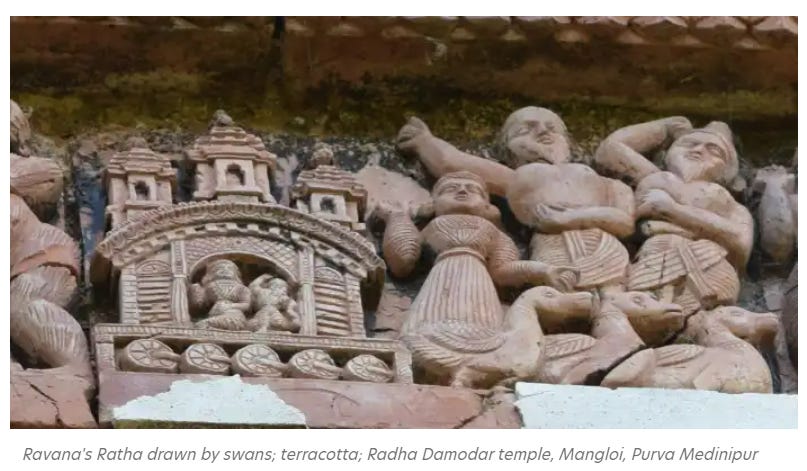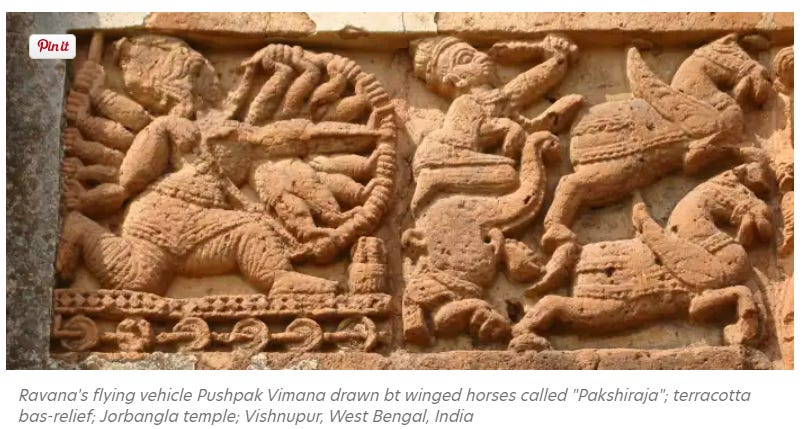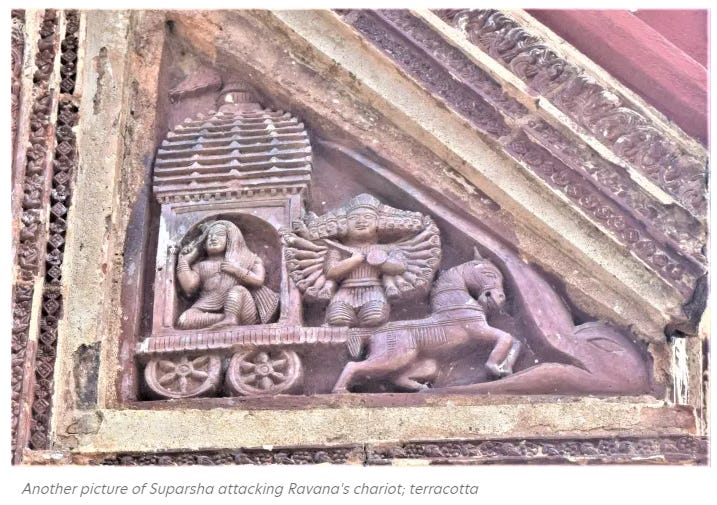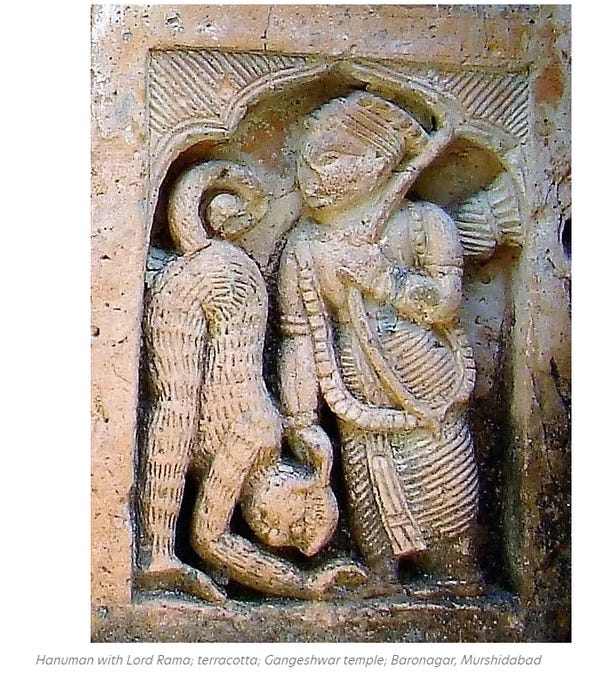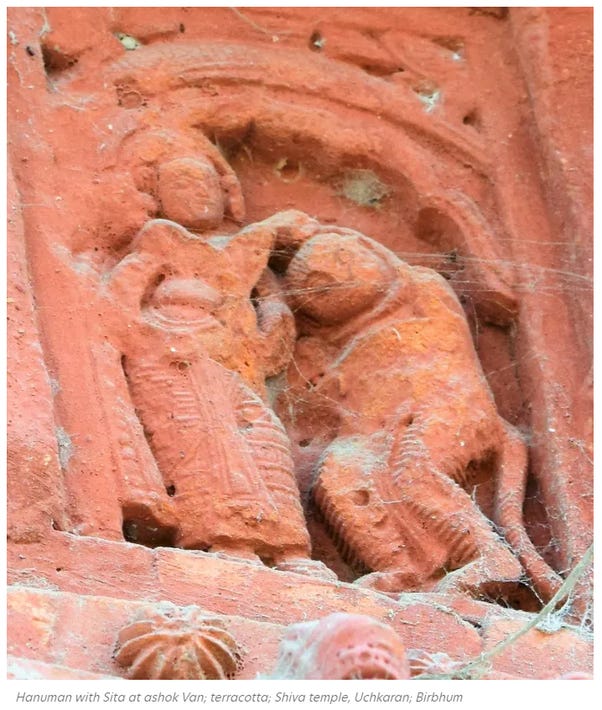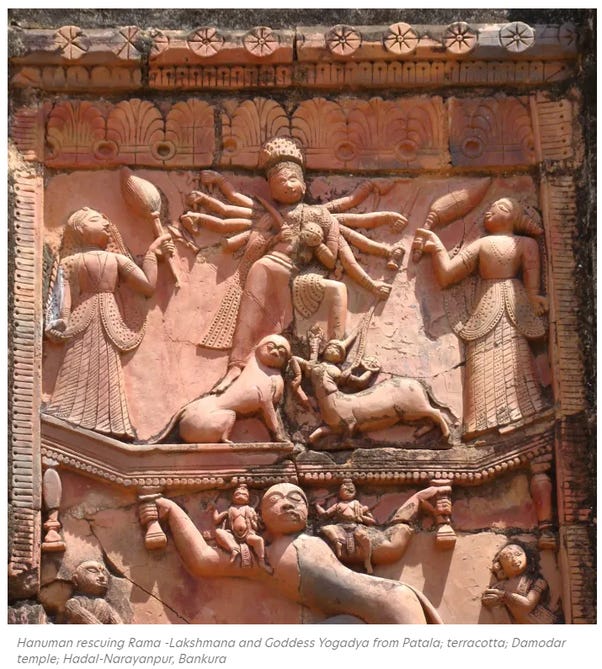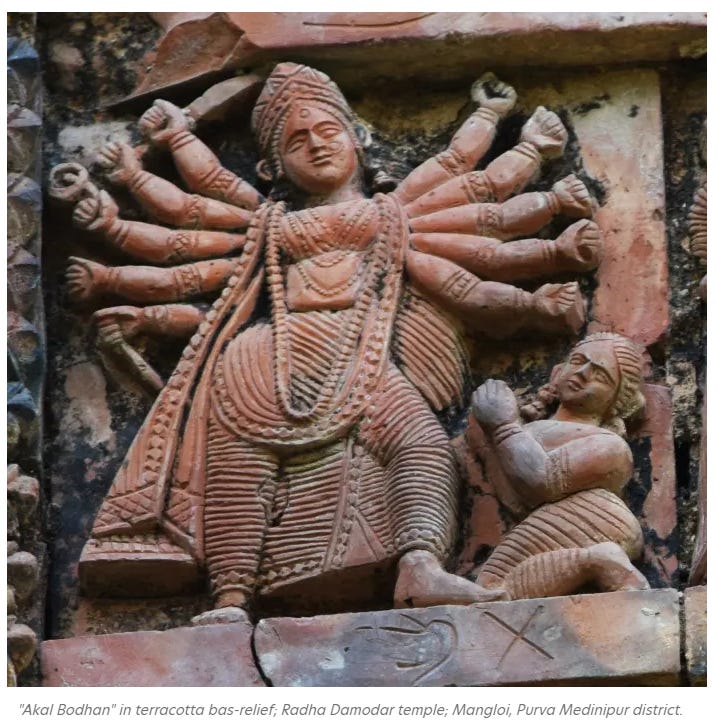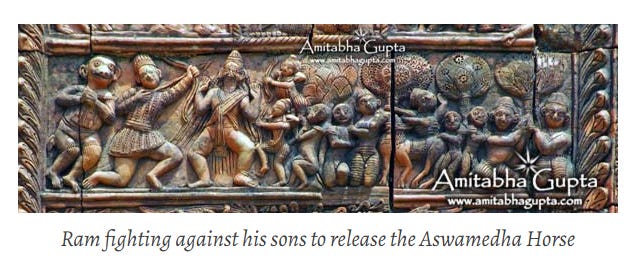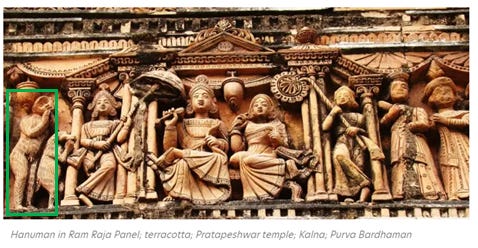Temple Architecture Decorative Elements: Bāṅlā Temple Architecture Decorations - Rāmāyaṇa (Śrīrām Pā̃cālī) scenes depictions
In Bāṅlā Architecture Temples, the depictions of Rāmāyaṇa correspond to Śrīrām Pā̃cālī1 written by Kr̥ttibāsa Ōjhā (1381 CE – 1461 CE)2 in Bāṅlā language.
Apart from Śrīrām Pā̃cālī, there have been many other Bāṅlā retellings of the tale like Adbhut Acharjer Rāmāyaṇa by Nityananda Acharya in 16th or 17th century CE which was almost a literal translation of Vālmīki Rāmāyaṇa, Dvija Lakṣmaṇa’s Rāmāyaṇa in the 18th century CE, etc. Some other attempts and incomplete translations were made by Kailash Basu, Bhabani Das, Kabichandra Chakraborty, Mahananda Chakraborty, Gangaram Das, Krishnadas, Ramananda Ghosh, Shankar Chakraborty, Chandravati, etc. There were also some pre-Kr̥ttibāsa Saṁskr̥ta retellings of the story in Abhinanda’s Rāmacarita during the rule of Dēvapāla and Sandhyakar Nandi’s Rāmacarita Kāvya in the reign of Rāmapāla which narrated the story with double meaning referring to both Rāma Nē̄mēya as well as Rāmapāla. But these versions are not as commonly depicted as Śrīrām Pā̃cālī.
Bāla Kāṇḍa (Childhood Episode)
Bāla Kāṇḍa (Childhood Episode) consists of the beginning part of the story. It consists of introduction of Kōsala king Nēmī (Daśaratha) and his wives, his unintentional killing of Śravaṇa (a child of blind parents), the birth of Nēmī’s sons, their marriage in Mithilā and their return to Kōsala’s capital Ayodhyā.
Nēmī unintentionally killing Śravaṇa
→ Nēmī unintentionally killing Śravaṇa:
Daśaratha killing Andhamuni (blind sage)’s son Śravaṇa ; terracotta; Jorbangla temple in Bishnupur district, West Bengal, India
→ Nēmī meeting Andhamuni after unintentionally killing Śravaṇa:
Daśaratha with the dead son of Andha Muni; terracotta; Jor Bangla temple in Bishnupur, Bankura district, West Bengal, India [Source: https://discover.hubpages.com/art/footwears-in-temple-decoration-in-west-bengal-india]
Sītā Sē̄radhvajī’s svayaṁvara
Rāma Nē̄mēya breaking Hara-dhanu
In Mithilā, Rāma Nē̄mēya breaks Hara-dhanu as the challenge of Sītā Sē̄radhvajī’s svayaṁvara.
This results in king Sīradhvaja (Mithilā Janaka) to have Rāma and his 3 brothers each marry a princess of Mithilā.
→ Rāma Nē̄mēya breaking Hara-dhanu:
Rāma Nē̄mēya breaking Hara-dhanu (Śiva’s bow) depicted as a lion-faced bow — terracotta relief at Charbangla temple in Baronagar, Murshidabad, West Bengal, India [Source: Lions in the Decoration of Temples in West Bengal]
Rāma Jāmadagnēya confronts Rāma Nē̄mēya for breaking Hara-dhanu
However, when the entourage is about to leave Mithilā, the warrior-sage Rāma Jāmadagnēya confronts Rāma Nē̄mēya for breaking Hara-dhanu. Once Rāma Nē̄mēya proves his capability and divinity, Rāma Jāmadagnēya lets the entourage pass.
→ Rāma Jāmadagnēya confronts Rāma Nē̄mēya for breaking Hara-dhanu:
Rāma Jāmadagnēya confronts Rāma Nē̄mēya for breaking Hara-dhanu; Jorbangla temple in Bishnupur, West Bengal, India [Source: https://discover.hubpages.com/religion-philosophy/Chiranjivi-or-Immortals-in-Hinduism-and-their-presence-in-Bengal-temple-decorations]
Araṇya Kāṇḍa (Forest episode)
Araṇya Kāṇḍa (Forest episode) includes the story from the point of forest exile of Rāma Nē̄mēya, Lakṣmaṇa Nē̄mēya and Sītā Sē̄radhvajī into Pañcavaṭī forest till Sītā’s abduction by Rāvaṇa and her subsequent search until the beginning of the next part of the story, termed Kiṣkindhā Kāṇda (Kiṣkindhā episode).
→ Scenes of Pañcavaṭī:
Rāma Nē̄mēya, Lakṣmaṇa Nē̄mēya and Sītā Sē̄radhvajī; tucco work; Balaji temple in Malancha, Kharagpur, Paschim Medinipur district, West Bengal, India [Source: https://discover.hubpages.com/art/lord-rama-without-a-bow-arrows-janaki-nath-temple-nandigram-medinipur-west-bengal]
Guhak ferrying Rāma Nē̄mēya, Lakṣmaṇa Nē̄mēya and Sītā Sē̄radhvajī [Source: Workers of Different Professions in Bengal Temple Decorations]
Rāma Nē̄mēya with Guhaka; vultures are shown perched on trees [Source: Birds in the Decoration of Temples in West Bengal]
Conflict with Śūrpaṇakhā
Śūrpaṇakhā (she whose fingernails are like winnowing fans)3 is Rāvaṇa’s younger sister.
She met the exiled Rāma during a visit to Pañcavaṭī, and tried to propose to him but Rāma rejected her advances, telling her that he was faithful to his wife Sītā and thus would never take another wife. Rejected, Śūrpaṇakhā then approached his younger brother, Lakṣmaṇa, who said that he is only second to Rāma and therefore not worthy of her. Infuriated, Śūrpaṇakhā returned to her demonic form and attacked Sītā, but was thwarted by Lakṣmaṇa, who cut off her nose.
Śūrpaṇakhā fled to Rāvaṇa’s court and spoke to her brother of the disgrace she had suffered. Her brother, hearing of Sītā’s beauty, decided to kidnap Sītā. Despite opposition from their brother, Vibhīṣaṇa, Rāvaṇa kidnapped Sītā, thus triggering the events that led to Battle of Laṇkā.
→ Lakṣmaṇa cutting-off Śūrpaṇakhā’s nose:
Lakṣmaṇa cutting-off Śūrpaṇakhā’s nose; terracotta plaque; Shiva temple in Uchkaran village, Birbhum district, West Bengal, India [Source: https://discover.hubpages.com/art/violence-against-women-reflections-in-the-decorations-of-temples-of-west-bengal]
Lakṣmaṇa cutting-off Śūrpaṇakhā’s nose; terracotta plaque; Lakshmi Janardan temple in Ghurisha village, Birbhum district, West Bengal, India [Source: https://discover.hubpages.com/art/violence-against-women-reflections-in-the-decorations-of-temples-of-west-bengal]
Sītā’s abduction by Rāvaṇa
Rāvaṇa reaches Pañcavaṭī on his flying chariot (Puṣpaka Vimāna) to abduct Sītā. He takes the help from Mārīca who takes the form of a golden deer to distract Rāma and Lakṣmaṇa, while he forcefully abducts Sītā. Mārīca is killed in this process.
The scenes include depictions of Rāvaṇa’s flying chariot (Puṣpaka Vimāna), Rāvaṇa carrying Sītā in his chariot, the vulture Jaṭāyū attacking and getting killed by Rāvaṇa after he has abducted Sītā, and a mythical bird called Suparṣa attacking Rāvaṇa after he has abducted Sītā.
Rāvaṇa’s flying chariot depictions
Rāvaṇa started thinking of his next course of action, and then flew in his aerial chariot across the sea to meet his ally, Mārīca.
→ Rāvaṇa’s flying chariot depictions (before having abducted Sītā) :
Rāvaṇa’s haṃsa-drawn flying chariot [Source: Birds in the Decoration of Temples in West Bengal]
Rāvaṇa’s haṃsa-drawn flying chariot; terracotta; Radha Damodar temple, Mangloi, Purba Medinipur district, West Bengal, India [Source: https://discover.hubpages.com/art/ratha-or-chariot-part-ii-chariots-in-bengal-temple-decoration]
Rāvaṇa’s Pakṣirāja (winged-horse)-drawn flying chariot; terracotta bas-relief; Jorbangla temple in Bishnupur, West Bengal, India [Source: https://discover.hubpages.com/education/ratha-or-chariot-partb-i]
Mārīca-Badha (Mārīca’s killing)
Rāvaṇa instructed Mārīca to turn into a golden deer with silver spots and graze in the vicinity of Rāma’s hermitage. On seeing the deer, Sītā got captivated by him, and told Rāma and Lakṣmaṇa to catch him. When the brothers left Sītā alone, Rāvaṇa abducted her.
→ Mārīca-Badha:
Rāma killing Mārīca (in anthrocephalic deer form); terracotta; Vishnu temple in Joypur, Bankura district, West Bengal, India [Source: https://discover.hubpages.com/art/HUNTERS-AND-HUNTING-IN-THE-DECORATIONS-OF-TEMPLES-OF-WEST-BENGAL]
Rāma killing Mārīca (in form of human emerging out of a deer); terracotta; Charbangla temple in Baronagar, Murshidabad district, West Bengal, India [Source: https://discover.hubpages.com/art/bangles-in-temple-decoration-of-west-bengal]
Jaṭāyū attacking Rāvaṇa who has kidnapped Sītā
After abducting Sītā, Rāvaṇa flees the place but is seen by the vulture Jaṭāyū. Jaṭāyū attacks Rāvaṇa, who cuts off Jaṭāyū’s wing killing him in the process.
→ Jaṭāyū attacking Rāvaṇa:
Jaṭāyū attacking Rāvaṇa; mural on stucco; Rama temple in Jayantipur village, Chandrakona, Paschim Medinipur district, West Bengal, India [Source: https://discover.hubpages.com/art/violence-against-women-reflections-in-the-decorations-of-temples-of-west-bengal]
Suparṣa attacking Rāvaṇa who has kidnapped Sītā
→ Suparṣa attacking Rāvaṇa who has kidnapped Sītā:
Suparṣa attacking Rāvaṇa who has kidnapped Sītā — Rāvaṇa and Sītā are inside a horse-drawn flying chariot, Rāvaṇa is shown with single head [Source: Birds in the Decoration of Temples in West Bengal]
Suparṣa attacking Rāvaṇa who has kidnapped Sītā — 10-headed Rāvaṇa is riding a horse-drawn makara(?)-headed chariot with Sītā inside, with the horse also carrying a rider [Source: Birds in the Decoration of Temples in West Bengal]
Suparṣa attacking Rāvaṇa who has kidnapped Sītā — 10-headed Rāvaṇa is driving a horse-drawn temple-like chariot with Sītā inside [Source: Birds in the Decoration of Temples in West Bengal]
Kiṣkindhā Kāṇda (Kiṣkindhā episode)
While searching for Sītā, Rāma and Lakṣmaṇa reach the region called Kiṣkindhā, inhabited & ruled by vānaras. There, they meet Hanumān.
→ Hanumān bowing to Rāma Nē̄mēya:
Hanumān bowing to Rāma Nē̄mēya; stone carving; Ganpur, Birbhum district, West Bengal, India [Source: http://discover.hubpages.com/religion-philosophy/Chiranjivi-or-Immortals-in-Hinduism-and-their-presence-in-Bengal-temple-decorations]
Hanumān bowing to Rāma Nē̄mēya; terracotta; Gangeshwar temple in Baronagar, Murshidabad district, West Bengal, India [Source: http://discover.hubpages.com/religion-philosophy/Chiranjivi-or-Immortals-in-Hinduism-and-their-presence-in-Bengal-temple-decorations]
Hanumān bowing to Rāma Nē̄mēya; terracotta; Mahaprabhu temple; Illambazar, Birbhum district, West Bengal, India [Source: https://discover.hubpages.com/art/bangles-in-temple-decoration-of-west-bengal]
Sundara Kāṇḍa (Beautiful Episode)
Sundara Kāṇḍa consists of the part of the story detailing Hanumān's heroics.
Surasā & Siṁhikā confront Hanumān
After learning about Sītā, Hanumān assumes a gigantic form and makes a colossal leap across the sea to Laṇkā. Across the way he encounters the sea demons Surasā & Siṁhikā, and kills them.
→ Surasā & Siṁhikā confronting Hanumān:
Surasā & Siṁhikā confronting Hanumān; terracotta; Gangeshwar temple in Baronagar, Murshidabad district, West Bengal, India [Source: http://discover.hubpages.com/religion-philosophy/Chiranjivi-or-Immortals-in-Hinduism-and-their-presence-in-Bengal-temple-decorations]
Hanumān meeting Sītā Sē̄radhvajī in Aśōka garden
After reaching Laṇkā, Hanumān finds and meets Sītā in Aśōka garden. He offers to carry Sītā back to Rāma, but she refuses, stating that her insult must be avenged by Rāma himself.
→ Hanumān meeting Sītā in Aśōka garden:
Hanumān meeting Sītā in Aśōka garden; terracotta; Shiva temple, Uchkaran, Birbhum district, West Bengal, India [Source: http://discover.hubpages.com/religion-philosophy/Chiranjivi-or-Immortals-in-Hinduism-and-their-presence-in-Bengal-temple-decorations]
Hanumān rescuing Rāma, Lakṣmaṇa and Yōgādyā from Pātāla
Mahirāvaṇa was Rāvaṇa’s son who worshipped the deity Mahāmayā or Yōgādyā.
On being commanded by Rāvaṇa, he kidnapped Rāma and and brought them to the underworlds for sacrificing them to the deity. However, Hanumān took the form of a fly and asked the deity if she had sanctioned this sacrifice. She advised Hanumān to tell the two brothers not to bow down to her when asked by Mahirāvaṇa, but rather ask him to demonstrate to them how to bow down. On Mahirāvaṇa getting down on his knees to show them, Hanumān who was behind the deity immediately took her straight sword (khadga) and killed Mahirāvaṇa.
At this, Mahirāvaṇa’s unborn child Ahirāvaṇa emerged from the womb and immediately engaged in desperate battle with Hanumān. Ultimately Hanumān succeeded in lifting Ahirāvaṇa by his legs and throwing him upon the ground thus killing him. This incident was taken by Kr̥ttibāsa from the Kubjikatantra composed ~9th century CE and was subsequently mentioned in some later texts too, like Annadamaṅgalkāvya of 18th century CE.
After the killing of Mahirāvaṇa and Ahirāvaṇa , the three of them were preparing to return back from Pātāla when the deity rebuked them, asking who will worship her in Pātāla now. In Śrīrām Pā̃cālī, the episode ends with Hanumān rescuing her, However, the details, are mentioned in, and therefore the depictions are sourced from, Yōgādyā Vandanā. With Lakṣmaṇa on his left shoulder and Rāma on his right shoulder, Hanumān sets out with the idol of Yōgādyā on his head.
Hanumān killing Ahirāvaṇa
After Mahirāvaṇa’s death, his unborn child Ahirāvaṇa emerged from the womb and immediately engaged in desperate battle with Hanumān. Ultimately Hanumān succeeded in lifting Ahirāvaṇa by his legs and throwing him upon the ground thus killing him.
This incident was taken by Kr̥ttibāsa from the Kubjikatantra composed ~9th century CE and was subsequently mentioned in some later texts too, like Annadamaṅgalkāvya of 18th century CE.
→ Hanumān killing Ahirāvaṇa:
Cropped image of Hanumān killing Ahirāvaṇa [Source: Brick Temple Towns of Bankura – Part I : Bishnupur]
Hanumān rescuing Rāma, Lakṣmaṇa and Yōgādyā from Pātāla
After the killing of Mahirāvaṇa and Ahirāvaṇa , the three of them were preparing to return back from Pātāla when the deity rebuked them, asking who will worship her in Pātāla now.
The depictions are sourced from Yōgādyā Vandanā: with Lakṣmaṇa on his left shoulder and Rāma on his right shoulder, Hanumān sets out with the idol of Yōgādyā on his head.
From https://www.indica.today/research/conference/sri-rama-and-ramayana-tradition-in-bengal/:
Kr̥ttibāsa Rāmāyaṇa says,
‘Śatrure mariya jatra koilo tinjon
Mahir pujito dēvī kohen tokhon.
Sadhiya Rāmer karya colila satvar
Seva ke koribe mama patal bhitor.’
(After killing the enemies the three of them started on the return journey when the Devi worshipped by Mahi told them, you are returning back quickly after doing Ram’s work but who will worship me in the netherworlds?)
At this Hanumān salutes the deity and rescues her from the netherworlds –
‘Eto śuni Hanumān kori namaskār
Dēvīre Pātāla hote korilo uddhār.’[6]
Kr̥ttibāsa’s story of Dēvī Mahāmāya or Jōgādyā ends here but we get the continuation in another Bāṅlā text of Yōgādyā Vandanā:
Bām skandhē Lakṣmaṇa dakṣiṇa skandhē Rāma
Mātāyē pratimā kori jailen Hanumān.
Martyadēśa madhyē āchē Kṣīrgrām nām,
Tathayē rakhilen toma Bīr Hanumān.[7]
(With Lakṣmaṇa on his left shoulder and Rāma on his right shoulder, Hanumān set out with the idol of the Dēvī on his head. There is a place on the earth called Kṣīrgrām where Hanumān kept the Dēvī’s idol.)
→ Hanumān rescuing Rāma, Lakṣmaṇa and Yōgādyā from Pātāla:
Hanumān rescuing Rāma, Lakṣmaṇa and Yōgādyā from Pātāla; terracotta; Damodar temple, Hadal-Narayanpur, Bankura district, West Bengal, India [Source: http://discover.hubpages.com/religion-philosophy/Chiranjivi-or-Immortals-in-Hinduism-and-their-presence-in-Bengal-temple-decorations]
Yuddha Kāṇḍa (War Episode) / Laṇkā Kāṇḍa (Laṇkā Episode)
Second Conflict with Indrajit
In their second conflict, Indrajit fatally wounds Lakṣmaṇa. Hanumān is forced to fly to Himalaya and bring back Sañjīvanī (life bringer) herb, bringing the herb-filled mountain in the process
→ Severely wounded Lakṣmaṇa Nē̄mēya:
Lakṣmaṇa Nē̄mēya is severely wounded in the battle & is lying on the lap of Rāma Nē̄mēya — Hadal-Narayanpur, Bankura district, West Bengal, India [Source: Hadal-Narayanpur, the little known heaven of terracotta art]
Akāl Bodhan (Untimely Worship)
Rāma Nē̄mēya is said to have performed the worship of Durgā during the autumn, which is not the standard time for performing the same, the spring being the ideal time. He did that to have the special power required to defeat Rāvaṇa.
In temple decorations, this scene is depicted by showing Rāma performing the worship of Durgā, where Rāvaṇa is also seen present in most cases.
→ Akāl Bodhan:
Rāma Nē̄mēya and 10-headed Rāvaṇa riding chariots; terracotta bas-relief; Damodar temple (Mejo Taraf) in Hadal-Narayanpur, Bankura district, West Bengal, India [Source: https://discover.hubpages.com/art/ratha-or-chariot-part-ii-chariots-in-bengal-temple-decoration]
Akal Bodhan; terracotta bas-relief; Sridhar temple in Sonamukhi, Bankura district, West Bengal, India [Source: https://discover.hubpages.com/art/different-forms-of-durga-the-mother-goddess-in-temple-decorations-of-west-bengal-india]
Akal Bodhan; terracotta bas-relief; Radha Damodar temple in Mangloi, Purba Medinipur district, West Bengal, India [Source: https://discover.hubpages.com/art/different-forms-of-durga-the-mother-goddess-in-temple-decorations-of-west-bengal-india]
Battle of Laṇkā
Battle of Laṇkā is the final battle of almost all versions of Rāmāyaṇa, depicting Rāma Nē̄mēya and his army battling against Rāvaṇa and his army.
In most cases, Śrīrām Pā̃cālī’s Battle of Laṇkā depictions feature Hanumān carrying Rāma Nē̄mēya on his shoulders, battling against chariot-riding 10-headed Rāvaṇa. Rāvaṇa is usually shown with folded hands.
→ Hanumān carrying Rāma Nē̄mēya on his shoulders, battling against chariot-riding 10-headed Rāvaṇa:
Hanumān carrying Rāma Nē̄mēya on his shoulders, battling against chariot-riding 10-headed Rāvaṇa; Terracotta panel; Charbangla temple in Baronagar, Murshidabad district, West Bengal, India [Source: Chiranjivi or Immortals in Hinduism and their presence in Bengal temple decorations]
→ Both Rāma Nē̄mēya and 10-headed Rāvaṇa riding chariots:
Rāma Nē̄mēya and 10-headed Rāvaṇa riding chariots; terracotta; Shiva temple, Sil Para, Rajbalhat, Hooghly district, West Bengal, India [Source: https://discover.hubpages.com/art/ratha-or-chariot-part-ii-chariots-in-bengal-temple-decoration]
→ Other battle scenes:
Jāmbaban in battle; terracotta; Radhabinod temple in Joydev, Birbhum district, West Bengal, India [Source: https://discover.hubpages.com/religion-philosophy/Chiranjivi-or-Immortals-in-Hinduism-and-their-presence-in-Bengal-temple-decorations]
Uttara Kāṇḍa (Latter Episode)
This episode includes interactions of Rāma, Bharat, Lakṣmaṇa and Śatrughna with Rāma’s sons Lava & Kuṣa.
→ Rāma battling against Lava-Kuṣa:
Rāma battling against Lava-Kuṣa; terracotta; Shiva temple in Supur, Birbhum district, West Bengal, India [Source: https://discover.hubpages.com/religion-philosophy/Chiranjivi-or-Immortals-in-Hinduism-and-their-presence-in-Bengal-temple-decorations]
Rāma fighting against Lava-Kuṣa to release the Aśvamēdha Horse [Source: https://amitabhagupta.wordpress.com/2013/06/04/brick-temple-towns-of-bankura-part-iv-joypur-gokulnagar/]
Rāma Rāja panels
Rāma Rāja panels depict the finale of Śrīrām Pā̃cālī, with Rāma Nē̄mēya & Sītā Sē̄radhvajī as the king and queen of Kōsala kingdom. Multiple other characters may be shown along with them.
This scene can be used as conclusion of Yuddha Kāṇḍa or of Śrīrām Pā̃cālī itself.
→ Rāma Rāja panels examples:
Rāma Rāja panel; Rameshwar Shiva temple in Ilambazar; Birbhum district, West Bengal, India [Source: Chiranjivi or Immortals in Hinduism and their presence in Bengal temple decorations]
Rāma Rāja panel featuring Hanumān (monkey) and Jāmbaban (bear); terracotta; Damodar temple in Hadal-Narayanpur, Bankura district, West Bengal, India [Source: Chiranjivi or Immortals in Hinduism and their presence in Bengal temple decorations]
Rāma Rāja panel featuring Hanumān and Jāmbaban together on left (highlighted); terracotta; Pratapeshwar temple in Kalna, Purba Bardhaman district, West Bengal, India [Source: Chiranjivi or Immortals in Hinduism and their presence in Bengal temple decorations]
Rāma Rāja panel featuring Hanumān; stucco; Shiva temple, Nanur, Birbhum district, West Bengal, India [Source: Chiranjivi or Immortals in Hinduism and their presence in Bengal temple decorations]
References:
Bengali Ramayana: https://www.indica.today/research/conference/sri-rama-and-ramayana-tradition-in-bengal/
Documenting the worship of Rama in Bengal history: https://monidipa.net/2020/08/10/3952/
https://en.wikipedia.org/wiki/Krittivasi_Ramayan
https://en.wikipedia.org/wiki/Krittibas_Ojha
https://en.wikipedia.org/wiki/Shurpanakha









